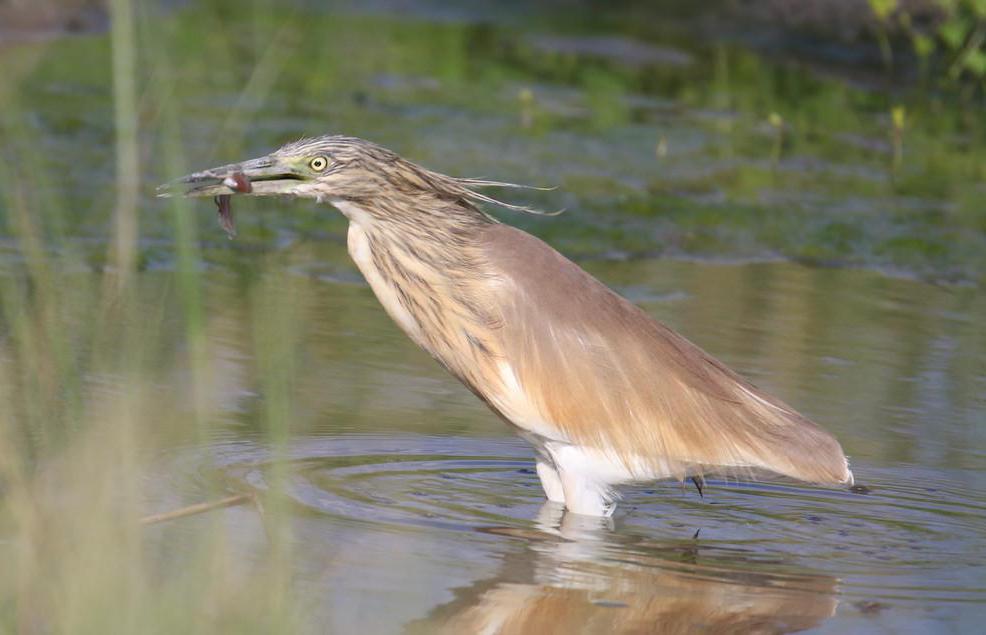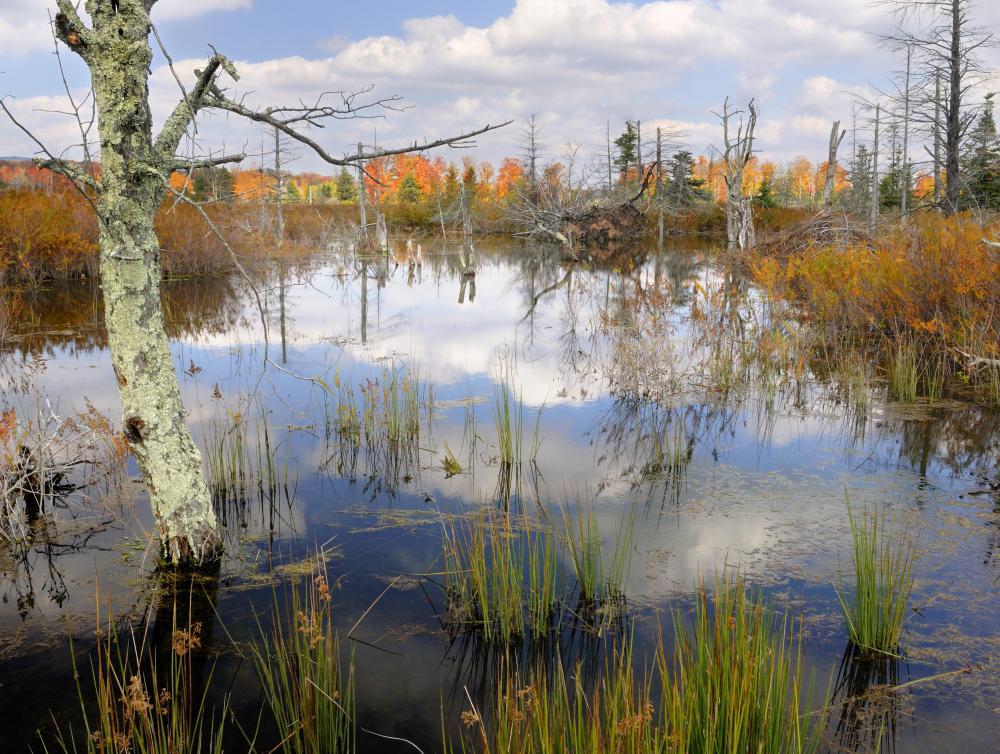At AllThingsNature, we're committed to delivering accurate, trustworthy information. Our expert-authored content is rigorously fact-checked and sourced from credible authorities. Discover how we uphold the highest standards in providing you with reliable knowledge.
What is a Bittern?
A bittern is a wading marsh bird in the heron family. The birds can be found all over the world, inhabiting wetlands and other watery areas and eating the fauna that they find. The bittern is a generally shy, solitary animal, and it can be unusual to see one, but the loud booming call of the male can inform birdwatchers that bitterns are in the area, even if unseen. Some animal parks and reserves also keep bitterns, and they can sometimes be seen in zoos as well.
The name for the birds comes from the Old French butor, which is believed to have been derived from the Latin butionem, for “bittern” and taurus for “bull.” Allegedly, the birds were given this Latin name because of their characteristic loud cries. Two genera collectively make up the bitterns. The first genus, Botaurus, comprises larger bitterns such as the Great Bittern and American Bittern. Smaller bitterns like the Least Bittern, Cinnamon Bittern, and Dwarf Bittern are in the second genus, Ixobrychus. All told, around 14 living bittern species have been identified on every continent except Antarctica.

At first glance, a bittern might look like a small heron. The birds do have a few distinguishing differences, however. Bitterns have shorter necks than herons do, and they also have more compact, stocky bodies. Their plumage tends to be mottled brown in color, ideally suited to camouflage among the reeds and grasses of their wetland habitat. Like herons, bitterns have long beaks well suited to digging through mud and other materials for food.

Fish, frogs, and other small swamp animals comprise the bulk of a bittern's diet. Like herons, bitterns may stand in water imitating reeds while they hunt. When flying, bitterns also retract their necks, rather than stretching them out as some birds do. Many bittern species are also migratory, and some larger bitterns are treated as game birds in several regions of the world.

Healthy wetlands may be able to sustain a reasonable bittern population, and the birds may be used as an index species to asses the health of the environment. A decline in the number of bitterns around a wetland can suggest that they are having difficulty finding food or habitat, which generally indicates an ecological imbalance. Drastic alterations in water level can also have an impact on bitterns, as they tend to nest low to the ground in wetlands, and flooding can destroy a nest.
Frequently Asked Questions
What exactly is a bittern?

A bittern is a wading bird belonging to the heron family, Ardeidae. They are known for their secretive behavior, often dwelling in reeds and marshes where they blend in due to their camouflaged plumage. Bitterns have a distinctive booming call that can be heard during the breeding season, which contributes to their elusive reputation.
How does a bittern differ from other herons?
Bitterns are generally smaller and more secretive than many of their heron relatives. They have stout bodies and shorter necks, with a more cryptic coloration that helps them hide among marsh vegetation. Unlike the often-visible herons, bitterns are masters of camouflage, making them much harder to spot in their natural habitat.
Where can you typically find bitterns?
Bitterns are found in wetland habitats across the globe, from freshwater marshes to brackish environments. They are most commonly seen in dense reed beds where they can hunt for fish, amphibians, and insects. Their distribution ranges from North America and Europe to parts of Asia, with some species also present in Africa and Australia.
What do bitterns eat?
Bitterns primarily feed on a diet of fish, amphibians, insects, and crustaceans. They hunt by standing still or walking slowly through their wetland habitats, striking quickly with their long, sharp beaks when prey comes within reach. Their feeding habits contribute to the health of wetland ecosystems by controlling populations of their prey.
Are bitterns endangered?
The conservation status of bitterns varies by species. Some, like the American bittern, are not currently considered endangered. However, the Eurasian bittern has faced significant declines due to habitat loss and is listed as Near Threatened according to the IUCN Red List. Conservation efforts are crucial for protecting the habitats of these elusive birds.
How do bitterns communicate?
Bitterns are known for their unique vocalizations, especially the male's deep, booming call during the breeding season, which can be heard up to several kilometers away. This call is used to establish territory and attract mates. They also use a variety of other sounds for communication, including clacks and growls, particularly when threatened.
AS FEATURED ON:
AS FEATURED ON:














Discussion Comments
@stl156 - I was kind of wondering the same thing myself. I know a lot of the wetlands worldwide are being drained for farming and development and stuff like that, which is unfortunate for these birds and other wetland animals. From the article, it doesn't sound they they are hunted to the point of being harmed, so at least that is good.
The other thing I was curious about was what the bittern courting rituals were like. I know a lot of birds have interesting mating calls and things like that. Does anyone know if bitterns do anything interesting?
My family and I are planning a vacation to Australia next year, so maybe I will look up some of their bird species and see if I can spot anything interesting while I am there.
I was curious what the article meant by bitterns retracting their necks, so I looked up a picture of a bittern. You can definitely tell they are related to herons, but they sort of have their own look to them.
I would say the neck really is the distinguishing feature. They have the same basic head and bill shape as a heron, but their neck is pulled in, so it almost makes them look like they have a really long body that is all the same diameter, if that makes sense. If you all haven't seen one, I would definitely suggest you look at some pictures.
If there are so few bittern species, I wonder if any of them are threatened or endangered. Does anyone know? Do they typically live in freshwater wetlands or ones with more salinity?
@TreeMan - I don't believe bitterns are related at all to pelicans or flamingos, even though the latter is also a wading bird. The only thing I know for sure they are related to are egrets. Of the ones I have seen, egrets are typically white, and have a bunch of feathers that hang over the back of their head and around their neck. I always think of them as having "messy" feathers.
I just got into bird watching a year or so ago, so I am still learning as I go. I am pretty sure the only two species of bitterns in North America are the American bitter that the article mentions and the least bittern. Least bittern birds are usually found in the southeast US, but the American bittern can be found in the east.
I live near several marshes in South Carolina, but I have still never seen a bittern. It would definitely be neat if I could ever check that one off my list.
Are there any bittern relatives besides just herons? I always kind of thought flamingos and pelicans resembled herons, and both of those birds are also associated with water.
I don't really know a whole lot about bird watching, in general, but I enjoy watching birds and trying to find their nests when I am outdoors hiking or camping or something. Does anyone have a general idea of where bitterns live in North America? Since there are only 14 species, I would guess that they aren't common everywhere. The fact that there is a species called the American bittern should mean they live in the US.
If I ever heard a bittern calling, what would it sound like? I sort of know what a great blue heron sounds like. Are they similar or completely different?
@BambooForest- I wish I lived near a swamp or other place with lots of birds. I think most of us live too far from nature, and the most we have is a bird house that might get a few sparrows. It would be great to see bitterns and other birds when I looked outside.
I have a friend who lived near marsh land and he sees a lot of bitterns and other water birds in his yard a lot. It's gotten him interested in ornithology in general, something he never cared much about before moving there.
Post your comments